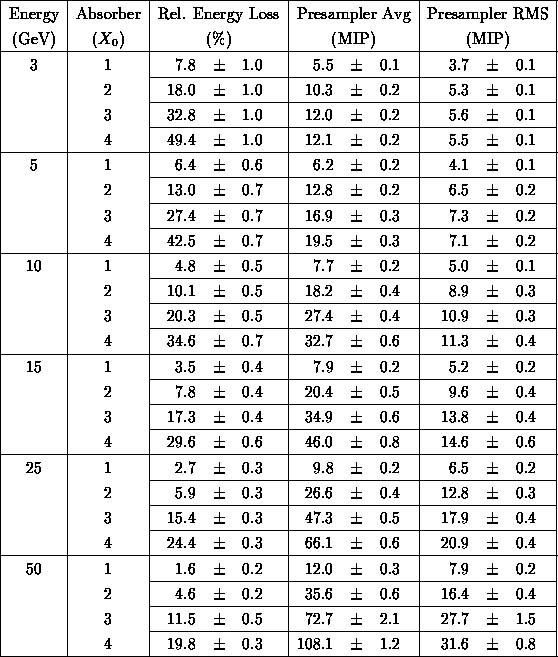
Fig. 16
Reconstructed energy distributions for 25 GeV
electrons for a mixture of the 1-4 X data before and after
application of the correction algorithm.
data before and after
application of the correction algorithm.
The results
for the corrected calorimeter response for electrons in the energy
range 3-50 GeV, are
shown in figure 15 . This procedure provides a
correction accurate to 3%for the energy range studied here, but for an overcorrection
of about 10%for the 3 X data points at low energy.
For electron energies greater than
5 GeV and for absorber thickness less than 2 X
data points at low energy.
For electron energies greater than
5 GeV and for absorber thickness less than 2 X , the values relevant to
the operation of the ZEUS detector, this simple correction algorithm
yields a systematic precision of 2%.
, the values relevant to
the operation of the ZEUS detector, this simple correction algorithm
yields a systematic precision of 2%.
The improvement in the energy resolution as well as in the energy scale
is shown in figure 16 . The energy distribution
of 25 GeV electrons for a merged 1-4 X data set is shown before
and after correction.
data set is shown before
and after correction.
We have designed, built, installed and operated a scintillator-tile presampler
for the forward and rear calorimeter of the ZEUS detector. The scintillation
light from the tiles is collected by wavelength-shifting fibers and guided
to multi-anode photomultipliers via clear fibers. The signals are shaped,
sampled and pipelined in the manner employed for the calorimeter itself,
easing the integration of the presampler in the ZEUS data acquisition system.
The performance of the tiles and fiber readout were monitored with a
cosmic-ray telescope and with collimated sources during production.
The single-particle detection efficiency is greater than 99%and the
response uniformity over the area of each of the 576 20 x 20 cm tiles is
better than 5%. An LED flasher system and scans with radioactive sources
have proven useful diagnostic tools since the installation of the presampler.
The in situ calibration with minimum-ionising particles during the 1995
data-taking period achieved a precision better
than 5%per tile. Test beam studies of a presampler prototype with the
final geometry and readout in combination with a prototype of the ZEUS
forward calorimeter verified the efficiency and uniformity results
and allowed the determination of backscattering contributions. Tests
with electrons were performed in the energy range 3-50 GeV with
0-4 radiation lengths of aluminium absorber. These studies
have proven the feasibility of an electron energy
correction accurate to better than 2%in the energy range and for the
configuration of inactive material relevant to the ZEUS detector.
tiles is
better than 5%. An LED flasher system and scans with radioactive sources
have proven useful diagnostic tools since the installation of the presampler.
The in situ calibration with minimum-ionising particles during the 1995
data-taking period achieved a precision better
than 5%per tile. Test beam studies of a presampler prototype with the
final geometry and readout in combination with a prototype of the ZEUS
forward calorimeter verified the efficiency and uniformity results
and allowed the determination of backscattering contributions. Tests
with electrons were performed in the energy range 3-50 GeV with
0-4 radiation lengths of aluminium absorber. These studies
have proven the feasibility of an electron energy
correction accurate to better than 2%in the energy range and for the
configuration of inactive material relevant to the ZEUS detector.
We would like to thank the technical support from the institutes
which collaborated
on the construction of the presampler,
in particular W. Hain, J. Hauschildt, K. Loeffler, A. Maniatis,
H.-J. Schirrmacher (DESY),
W. Bienge, P. Pohl, K.-H. Sulanke (DESY-IfH Zeuthen),
M. Gospic, H. Groenstege, H. de Groot, J. Homma, I. Weverling,
P. Rewiersma (NIKHEF), R. Mohrmann, H. Pause, W. Grell (Hamburg),
M. Riera (Madrid), R. Granitzny, H.-J. Liers (Bonn). We are also grateful for the
hospitality and
support of CERN, in particular the
help of L. Gatignon is much appreciated.
Finally we would like to thank R. Klanner for his enthusiastic support during all
phases of the project.
References
- 1
- The ZEUS Detector, Status Report, DESY (1993).
- 2
- A. Andresen et al. Nucl. Instrum. Methods A309 (1991) 101.
- 3
- A.Weisenberger et al., Nucl. Instrum. MethodsA327 (1993) 500.
- 4
- A Remote-Controlled High Voltage system for PMT's.
M.Gospic, H.Groenstege, NIKHEF-ETR 94-11
http://www.nikhef.nl/www/pub/et/zeus/presampler/presampler.html
L. Hubbeling, CERN-EP Internal report 78-5.
- 5
- A.Caldwell et al., Nucl. Instrum. Methods A321
(1992) 356.
- 6
- B.Krebs et al., Nucl. Instrum. Methods A323
(1992) 611.
- 7
- U.Behrens et al. Nucl. Instrum. Methods A289 (1990) 115.
A.Andresen et al. Nucl. Instrum. Methods A290 (1990) 95.
Studies of Particle Jets with an Interaction
Trigger, W.Kröger, Ph.D. Thesis, University of Hamburg, 1992.
- 8
- A Prototype Presampler for Uranium-Scintillator Calorimeter
in ZEUS, H.Grabosch et al., NIKHEF-H/93-11.
- 9
- Calibration of the Presampler for the Electron Energy Measurement in the ZEUS Detector, A.Bornheim, Diploma Thesis, Bonn IB 95-24 (1995) (in German)
- 10
- Shaping Amplifier for PMT signals for ZEUS, P.Rewiersma, I.Weverling,
NIKHEF-ETR 94-12.
This document was generated using the LaTeX2HTML
translator Version 0.5.3 (Wed Jan 26 1994) Copyright © 1993, Nikos Drakos,
Computer Based Learning Unit, University of Leeds.
, A.Bornheim
, J.Crittenden
, H.-J.Grabosch
,
M.Grothe
,
L.Hervas
, E.Hilger
, U.Holm
, D.Horstmann
,
V.Kaufmann
, A.Kharchilava
, U.Kötz
,
D.Kummerow
, U.Mallik
, A.Meyer
, M.Nowoczyn
, R.Ossowski
,
S.Schlenstedt
, H.Tiecke
,
W.Verkerke
, J.Vossebeld
, M.Vreeswijk
, S.M.Wang
, J.Wu
Physikalisches Institut der Universität Bonn, Bonn, Germany
Deutsches Elektronen-Synchrotron DESY, Hamburg, Germany
DESY-IfH Zeuthen, Zeuthen, Germany
Fakultät für Physik der Universität Freiburg i.Br., Freiburg i.Br., Germany
Hamburg University, II. Institute of Exp. Physics, Hamburg, Germany
University of Iowa Physics and Astronomy Dept, Iowa City, USA
Univer. Autonoma Madrid, Depto de Fisica Teorica, Madrid, Spain
NIKHEF and University of Amsterdam, Netherlands




















